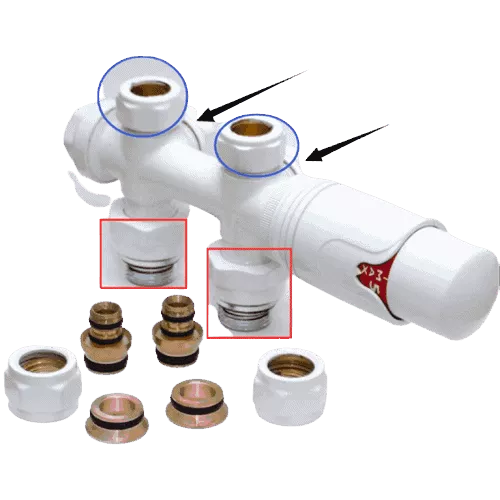What Is A Mixing Valve?
A mixing valve is generally used to control the mix of cold water and hot water. To clarify, it is a valve composed of several components inside… that takes both hot and cold water… and produces only hot water with a comfortable temperature. It not only regulates the water temperature in your shower or tub… but also protects you and your family by preventing scalding.
This is a magical valve. Have you ever wondered how the magic happens inside of it? We know you thought. So, you’re here today.

Inside Out
A mixing valve looks like a plus ‘+’ sign. It has four ends. On the upper side, it has a protection cap (plastic cover). The underneath area of the hat is an adjustable handle. You can set your desired temperature from here by adjusting this.
The rest three ends (2 inlets, one outlet) are working for the flow of water. The right side inlet is connected to the water heater, and the left one is associated with the regular water supply pipe. Consequently, hot water enters from the right side, and cold water enters from the left side. They blended inside and flowed out from the down end. You may see two letters engraved on the body of a mixing valve. C on the left side; indicates ‘Cold Water’ and H on the right side; means ‘Hot Water’.
Above all, there is a thermostat or temperature sensor… a hot valve seat on the hot water side, and a cold one on the cold water side… a slide valve, funnel, and spring is also available inside the valve.
This is just an introduction to a mixing valve and its parts. Let’s go deeper.
Here’s How A Mixing Valve Works
We all know that mixing valves mix hot and cold water to make a balanced temperature in water. From an ordinary people’s perspective, it’s just a simple process. But actually, it’s not.
It mixes water but keeping the perfect heat is not that easy. That’s where the thermostat or temperature sensor comes into play. It senses the heat of hot water and controls the temperature with a slide valve by mixing cold water with hot water accordingly.
Let’s make it more clear.
We said that two valve seats are available inside—one on the right and the other on the left. But there is a difference in their structure. For instance, if we take an inlet and divide it horizontally from the middle. Then we get two parts, one upper part, and the other lower part. For the two seats, one factor is blocked, and the other part is open, allowing water to flow. For the hot valve seat (in the hot water inlet side) upper part is blocked, and the lower part is open… and the reverse is valid for the cold side seat.
The slide valve moves up and down by sliding inside of the mixing valve. It moves with the help of an axial rod. When the hot water temperature is too high… the slide valve moves down (because the hot valve seat has the lower side open) and blocks the hot inlet. When the heat is down, it moves up and blocks the cold channel in the same vein.
But if a slight temperature change is required, then it does not move completely. It only moves as far as the water on both sides can be mixed to come to the right temperature.
Sometimes there is an adequate supply of hot water, but there is no supply of cold water. There is a possibility of scalding during this time. In such a case, the reaction process of the thermostat starts. It expands fully to close the hot valve seat and shuts down the hot water supply. As a result, the water supply by the outlet stops and prevents scalding.

Uses
Mixing valves were typically designed for use in individual applications. For example, single showering, hand wash basin tap, bath or tub fillers, etc… People use it to comfortably take a shower or wash hands with hot water… without fearing scalding.

Advantages
There are several advantages of using a mixing valve. E.g.
Increases the capacity of your hot water tank. For instance, if your hot water tank has a power of 10 –gallons. The mixing valve will make it around 15 by adding cold water with that hot water.
If the water heater temperature is low, Legionella bacteria are more likely to grow. A mixing valve will help set the temperature to 1400F that will kill 90% of the bacteria.
It will protect you from unwanted burning due to scalding.
Identification Of A Bad Working Mixing Valve
Determination of insufficient working mixing valves is essential to avoid sudden injuries and other problems. Consider these points to find out if your valve is working well or not…
The pressure of the water is not as bold as before. Then maybe the valve is not working well internally, or something is stuck inside.
No hot water is coming out. This is either the water heater problem or the valve is not working well.
The water supply is turned off from the shower or tub… also it drips hot water sometimes… then it’s a problem.
If the thermostat is not working well inside, you’ll consistently get hot water (high temperature).
If you observe any of these problems, then it’s better to check and repair them as soon as possible. Moreover, replacing is the best option. We can help to replace or fix the mixing valve problems. Besides, we are also responsible for manufacturing and selling high-quality brass valves… including Thermostatic Valves. Check our products to order or Contact Us for expert help and other information.
In conclusion, people always want comfort. Even when taking a bath in the shower or washing hands in the basin tap. So, they invented a mixing valve to get rid of cold water dissatisfaction. Grab yours and find your happiness.

Name



